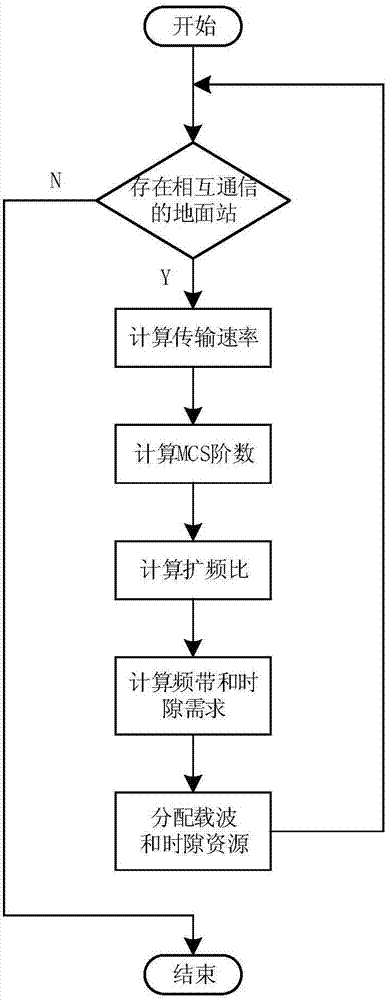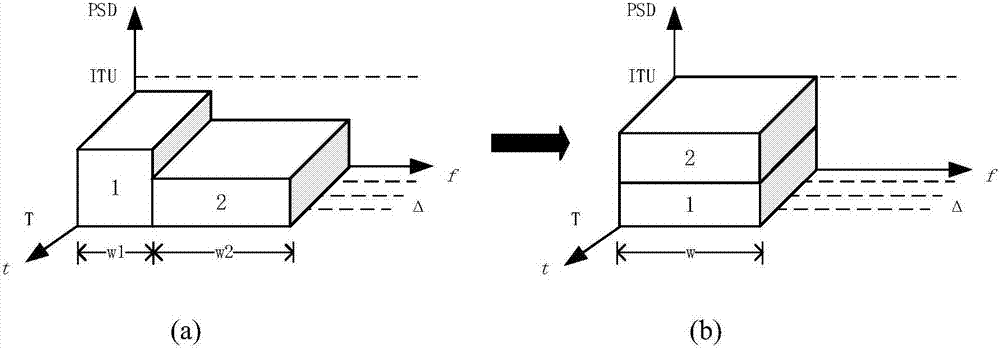Method for suppressing adjacent satellite interference in satellite communication system
A technology of satellite communication system and adjacent satellite, which is applied in the field of satellite communication, can solve the problems of system capacity reduction, difficult to achieve suppression of satellite communication system, and reduce the off-axis EIRP density of ground station antenna, so as to save channel resources and improve adjacent satellite interference , The effect of saving time-frequency channel resources
- Summary
- Abstract
- Description
- Claims
- Application Information
AI Technical Summary
Problems solved by technology
Method used
Image
Examples
Embodiment 1
[0051] In this embodiment, the antenna apertures of ground station 1 and ground station 2 are D 1 = 1.2m, D 2 =0.8m, the transmission rate of both parties is R 1 = R 2 =9.6Kbps, transmission time T=1.25s. System uplink frequency f u =14.2GHz, downlink frequency f d =11.9GHz, time slot length Δ=0.5ms;
[0052] Calculate the MCS order of both parties;
[0053] n 1 =2.00, η 2 =1.00
[0054] Therefore, when non-orthogonal multiple access is not introduced, the bandwidth occupied by both parties is
[0055]
[0056]
[0057] Utilize the method for suppressing adjacent star interference provided by the present invention, the steps are as follows figure 1 Shown; Calculate the spreading ratio of both sides as:
[0058] k 1 = 2,k 2 = 1
[0059] Calculate the bandwidth and time slot requirements of both parties, respectively:
[0060] w=9.6kHz, n=2500
[0061] In non-orthogonal multiple access, the bandwidth occupied by both parties is the same as the time slot requ...
Embodiment 2
[0064] In this embodiment, the antenna apertures of ground station 1 and ground station 2 are D 1 = 0.6m, D 2 =2.4m, the transmission rate is R 1 = 64Kbps, R 2 =512Kbps, transmission time T=23.5ms. System uplink frequency f u =14.2GHz, downlink frequency f d =11.9GHz, time slot length Δ=0.5ms;
[0065] Calculate the MCS order of both parties:
[0066] n 1 =0.67, η 2 =2.25
[0067] When non-orthogonal multiple access is not introduced, ground station 1 needs to double the spectrum in order to meet the ITU constraints, so the bandwidths occupied by both parties are:
[0068]
[0069] Utilize the method for suppressing adjacent star interference provided by the present invention, the steps are as follows figure 1 Shown; Calculate the spreading ratio of both sides as:
[0070] k 1 = 3,k 2 = 1
[0071] Calculate the bandwidth and time slot requirements of both parties as
[0072] w=288kHz, n=47
[0073] figure 2 It is a schematic diagram of saving channel reso...
PUM
 Login to View More
Login to View More Abstract
Description
Claims
Application Information
 Login to View More
Login to View More - R&D
- Intellectual Property
- Life Sciences
- Materials
- Tech Scout
- Unparalleled Data Quality
- Higher Quality Content
- 60% Fewer Hallucinations
Browse by: Latest US Patents, China's latest patents, Technical Efficacy Thesaurus, Application Domain, Technology Topic, Popular Technical Reports.
© 2025 PatSnap. All rights reserved.Legal|Privacy policy|Modern Slavery Act Transparency Statement|Sitemap|About US| Contact US: help@patsnap.com



